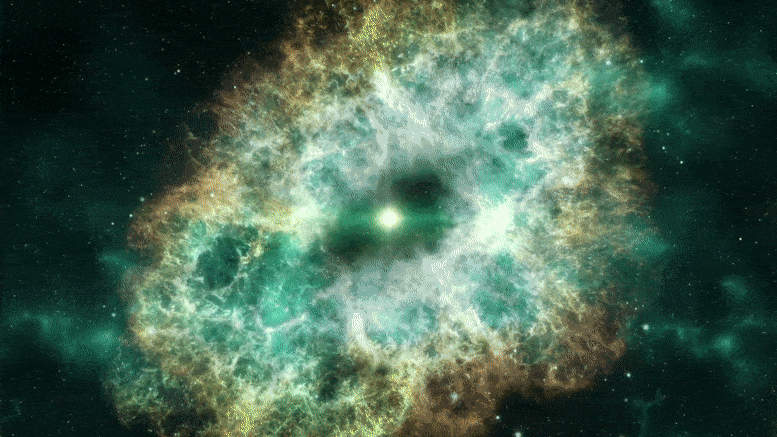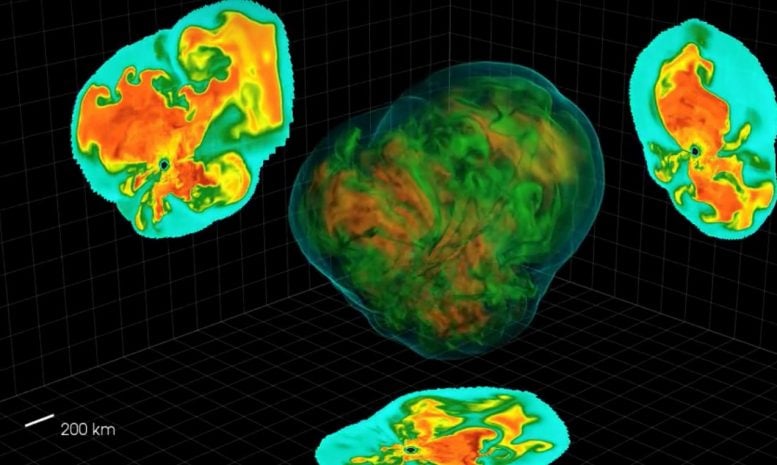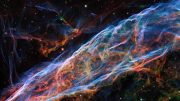
What Are Supernovae?
A supernova is the colossal explosion of a star. Scientists have identified several types of supernova. One type, called a “core-collapse” supernova, occurs in the last stage in the life of massive stars that are at least eight times larger than our Sun. As these stars burn the fuel in their cores, they produce heat. This heat produces pressure that pushes outward against the forces of gravity that pull inward on the star. For most of the life of a star, inward gravity and outward pressure are in balance and the star is stable. But as a star burns through its fuel and begins to cool, the outward forces of pressure drop. When the pressure drops low enough in a massive star, gravity suddenly takes over and the star collapses in just seconds. This collapse produces the explosion we call a supernova.

Researchers are using cutting-edge computers to build models of supernovae to understand these huge explosions. This image is a computer simulation of a supernova’s assumed heat signature, with projections shown at left, right, and bottom. Credit: Image courtesy of SciDAC
Supernovae are so powerful they create new atomic nuclei. As a massive star collapses, it produces a shockwave that can induce fusion reactions in the star’s outer shell. These fusion reactions create new atomic nuclei in a process called nucleosynthesis. Supernovae are considered one of the original sources of the elements heavier than iron in the Universe. Even the iron in your blood can be traced back to supernovae or similar cosmic explosions from long before our Sun had formed. Supernovae are thus essential to life.
After a core collapse supernova, all that remains is a dense core and hot gas called a nebula. When stars are especially large, the core collapses into a black hole. Otherwise, the core becomes an ultra-dense neutron star.
Another type of supernova, called a thermal runaway supernova, can occur when two stars orbit each other, and one or both of those stars is a white dwarf. White dwarfs are the remains of a star roughly the size of our Sun when it runs out of fuel. If the stars in one of these binary systems collide, or if one of the white dwarfs absorbs enough matter from the other star, the white dwarf can become a supernova.
Fast Facts
- A supernova occurs somewhere in the universe every 10 seconds.
- Supernovae are sources in our universe of elements, radiation, and neutrinos.
- Supernovae are cosmic particle accelerators that can be replicated in a laboratory in a project made possible with DOE Office of Science Fusion Energy Science program support.
DOE Office of Science: Contributions to Supernova Research
Through its Nuclear Physics program, the Department of Energy Office of Science supports research into the fundamental nature of matter. That includes how matter – including the elements – is created and the role of supernovae in that process. In partnership with other Office of Science programs, Nuclear Physics supports projects such as SciDAC, which advances the Scientific Computing Software and Hardware Infrastructure needed for projects such as simulating supernova explosions.
The Office of Science’s High Energy Physics program also uses supernovae as a tool to develop maps of the universe. In fact, Saul Perlmutter at Lawrence Berkeley National Laboratory as well as scientists Brian Schmidt and Adam Riess won the Nobel Prize for their use of Type Ia supernovae to discover dark energy. Researchers supported by the Office of Science are also using machine learning techniques to identify, categorize, and measure supernovae and other celestial objects that can reveal information about the structure of the universe.









Be the first to comment on "Science Made Simple: What Are Supernovae?"